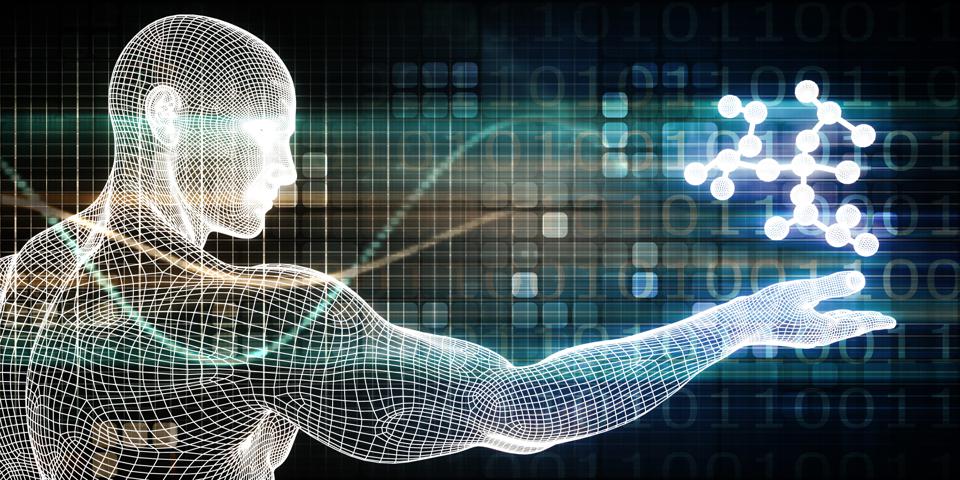
Molecular Science as a Scientific Field of Study
getty
An amazing aspect of living in The Fourth Industrial Era is that we are at a new inflection point in bringing emerging technologies to life. We are in an era of scientific breakthroughs that will change the way of life as we currently know it. While there are many technological areas of fascination for me, the meshing of biology with machine is one of the most intriguing. It fuses many elements of technologies especially artificial intelligence and pervasive computing. I have highlighted two frontiers of “mind-bending” developments that are on the horizon, Neuromorphic technologies, and human-machine biology.
Neuromorphic Technologies
Human computer interaction (HCI) was an area of research that started in the 1980s and has come a long way in a short period of time. HCI was the foundation for what we call neuromorphic computing, the integration of systems containing electronic analog circuits to mimic neuro-biological architectures present in the biological nervous system.
In 2018, in research funded by the Defense Advanced Projects Agency (DARPA) demonstrated that a person with a brain chip could pilot a swarm of drones using signals from the brain. There have been a variety of studies and experiments since then, and no doubt science combining neural networks and artificial intelligence is on a path to enhance and even upgrade human cognition capabilities.
Recently, a research team from Columbia University tested the convergence of neural networks. They combined brain implants, artificial intelligence, and a speech synthesizer to translate brain activity into recognizable robotic words. The implications of this neuromorphic technology are mind-boggling, including allowing paralyzed people the ability to communicate and the potential to read human thoughts via cognitive imaging. (1)
A Frontiers in Science publication involving the collaboration of academia, institutes, and scientists summed up the promise of the human computer interface, They concluded that “We can imagine the possibilities of what may come next with the human brain machine interface. A human B/CI system mediated by neural nanorobotics could empower individuals with instantaneous access to all cumulative human knowledge available in the cloud and significantly improve human learning capacities and intelligence. Further, it might transition totally immersive virtual and augmented realities to unprecedented levels, allowing for more meaningful experiences and fuller/richer expression for, and between, users. These enhancements may assist humanity to adapt emergent artificial intelligence systems as human-augmentation technologies, facilitating the mitigation of new challenges to the human species.” (2)
MORE FOR YOU
This week, Elon Musk announced that his neuroscience company, NeuraLink, created to develop cranial computers that can rapidly upload and process information, will demonstrate their lasts device that would let humans control computers with their mind via surgically implant electrodes. Linking brains to computers is no longer the stuff of science fiction.
Human-Machine Biology
The field of human and biological applications has many applications for medical science. This includes precision medicine, genome sequencing and gene editing (CRISPR), cellular implants, and wearables that can be implanted in the human body The medical community is experimenting with delivering nano-scale drugs (including anti-biotic “smart bombs” to target specific strains of bacteria. Soon they will be able to implant devices such as bionic eyes and bionic kidneys, or artificially grown and regenerated human organs. Succinctly, we are on the cusp of significantly upgrading the human ecosystem. It is indeed revolutionary.
This revolution will expand exponentially in the next few years. We will see the merging of artificial circuitries with signatures of our biological intelligence, retrieved in the form of electric, magnetic, and mechanical transductions. Retrieving these signatures will be like taking pieces of cells (including our tissue-resident stem cells) in the form of “code” for their healthy, diseased or healing states, or a code for their ability to differentiate into all the mature cells of our body. This process will represent an unprecedented form of taking a glimpse of human identity. (3)
In the future biocomputers may be able to store on the DNA of living cells. This technology could store almost unlimited amounts of data and allow the biocomputers to perform complex calculations beyond our current capabilities.
Researchers at the Technion have already created a biological computer, constructed within a bacterial cell. developed a complex biocomputer, that is, a programmed biological system that fulfills complex tasks. The research by Ph.D. student Natalia Barger and Assistant Professor Ramez Daniel, head of the Synthetic Biology and Bioelectronics Lab at the Technion’s Faculty of Biomedical Engineering, was published in September 2019 in the journal Nucleic Acids Research (NAR) “We built a kind of biological computer in the living cells. In this computer, as in regular computers, circuits carry out complicated calculations,” said Barger. “Only here, these circuits are genetic, not electronic, and information are carried by proteins and not electrons.” (4)
The Human-machine synergies now being explored offer us a glimpse into the not so distant future. Clearly, from the perspective of human augmentation, the promise is exciting. The future will also encompass moral issues to address such as containing super artificial intelligence, ensuring cyborg rights, and a whole host of other related ethical topics. It is evident is that human-machine interface will help pave our futures. How we harness it for good should be our focus. Perhaps that will be what the Fifth Industrial Revolution will codify.
Footnote: this past year I designed and wrote a graduate course for Georgetown University called Disruptive Technologies and Organizational Management. I am now enjoying teaching it. What excites me is receiving back insights on my assignments. Paraphrasing Leonardo Da Vinci, you should never stop learning in life. The imagination of my students as they contemplate the applications and fusion of emerging technologies in society and security is an inspiration.
Sources:
1) The New Techno-fusion by Chuck Brooks
2) Human Brain/Cloud Interface
3) Emerging Bio-Science and Health Security Implications for Biometrics by Chuck Brooks
4) Researchers turn bacterial cell into biological computer
